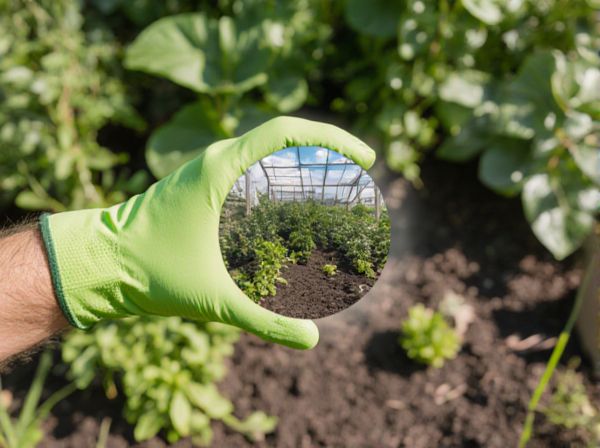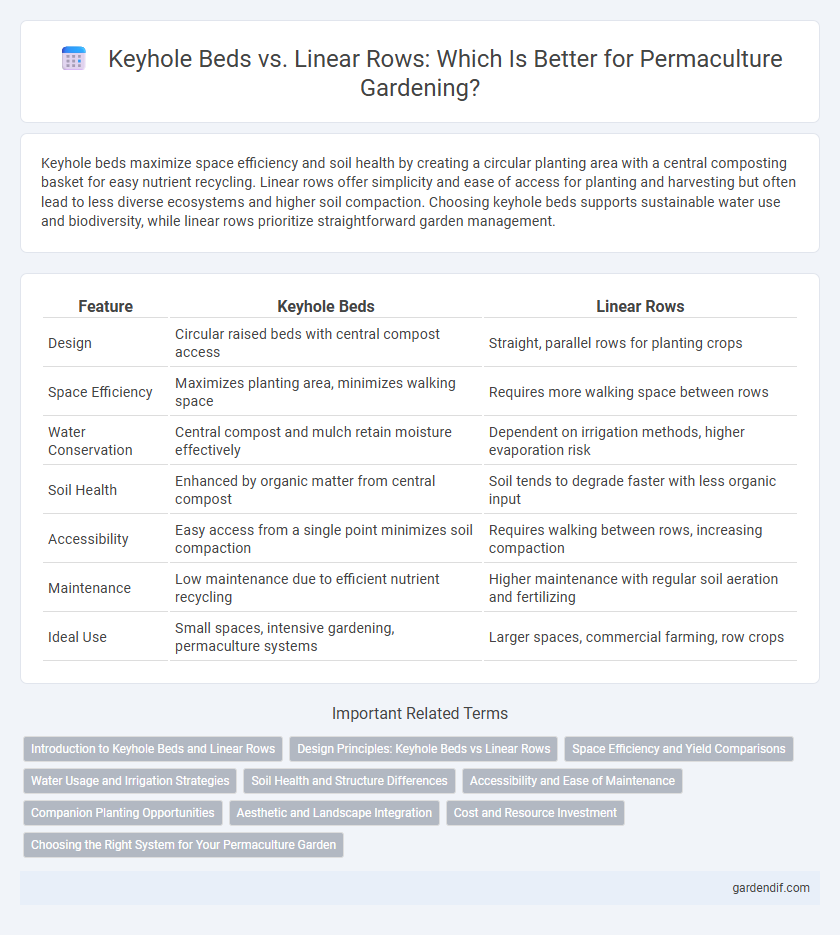
Keyhole Beds vs Linear Rows Illustration
Keyhole beds maximize space efficiency and soil health by creating a circular planting area with a central composting basket for easy nutrient recycling. Linear rows offer simplicity and ease of access for planting and harvesting but often lead to less diverse ecosystems and higher soil compaction. Choosing keyhole beds supports sustainable water use and biodiversity, while linear rows prioritize straightforward garden management.
Table of Comparison
| Feature | Keyhole Beds | Linear Rows |
|---|---|---|
| Design | Circular raised beds with central compost access | Straight, parallel rows for planting crops |
| Space Efficiency | Maximizes planting area, minimizes walking space | Requires more walking space between rows |
| Water Conservation | Central compost and mulch retain moisture effectively | Dependent on irrigation methods, higher evaporation risk |
| Soil Health | Enhanced by organic matter from central compost | Soil tends to degrade faster with less organic input |
| Accessibility | Easy access from a single point minimizes soil compaction | Requires walking between rows, increasing compaction |
| Maintenance | Low maintenance due to efficient nutrient recycling | Higher maintenance with regular soil aeration and fertilizing |
| Ideal Use | Small spaces, intensive gardening, permaculture systems | Larger spaces, commercial farming, row crops |
Introduction to Keyhole Beds and Linear Rows
Keyhole beds maximize space by incorporating a central access path surrounded by planting areas, enhancing soil fertility through compost in the core. Linear rows offer straightforward planting and maintenance but often require more space and can lead to soil compaction. Both designs support permaculture principles, with keyhole beds improving efficiency and water retention while linear rows simplify crop rotation and mechanization.
Design Principles: Keyhole Beds vs Linear Rows
Keyhole beds maximize space efficiency and accessibility by incorporating a central composting area surrounded by planting zones, enhancing soil fertility and water retention through circular design principles. Linear rows offer straightforward planting and maintenance but often sacrifice space optimization and biodiversity benefits found in keyhole configurations. The permaculture design prioritizes keyhole beds for their multifunctionality, promoting ecosystem health and resource conservation.
Space Efficiency and Yield Comparisons
Keyhole beds optimize space by maximizing planting area within a compact, circular layout, allowing easy access to all plants without stepping on soil, which improves soil structure and productivity. Linear rows simplify crop management and mechanization but often result in wasted pathways, reducing overall planting density and yield per square meter. Studies show keyhole beds can increase yields by up to 30% compared to linear rows due to enhanced microclimate conditions and efficient nutrient cycling.
Water Usage and Irrigation Strategies
Keyhole beds optimize water usage by concentrating irrigation at a central composting basket, allowing moisture to radiate outward and minimizing runoff, which reduces overall water consumption. Linear rows require more extensive irrigation systems such as drip lines or sprinklers, often leading to uneven water distribution and higher evaporation rates. Implementing mulching and water-retentive soil amendments enhances efficiency in both methods but the keyhole design inherently promotes superior water conservation through its compact, circular layout.
Soil Health and Structure Differences
Keyhole beds enhance soil health by promoting better aeration and moisture retention through their circular design, which encourages diverse root growth and prevents soil compaction. In contrast, linear rows often lead to soil degradation due to repeated foot traffic and limited root distribution, reducing organic matter and microbial activity. The radial layout of keyhole beds supports improved soil structure, fostering beneficial organisms and nutrient cycling more effectively than traditional linear planting methods.
Accessibility and Ease of Maintenance
Keyhole beds provide enhanced accessibility by allowing gardeners to reach the center of the bed from multiple angles, reducing soil compaction and minimizing the need to step inside the growing area. Unlike linear rows, keyhole designs consolidate space efficiently, making maintenance tasks like planting, weeding, and harvesting quicker and less physically demanding. This layout supports sustainable gardening practices by optimizing water use and promoting healthier plant growth through easier soil management.
Companion Planting Opportunities
Keyhole beds maximize companion planting opportunities by creating a circular design that allows plants with complementary traits to grow closely, enhancing pest control and nutrient sharing. Linear rows limit plant diversity and companion benefits due to restricted spacing and less variety in microclimates. The compact structure of keyhole beds fosters richer biodiversity and soil health compared to traditional linear arrangements.
Aesthetic and Landscape Integration
Keyhole beds offer a visually appealing circular design that enhances garden aesthetics and blends seamlessly into natural landscapes, promoting organic growth patterns. Linear rows, while traditional, often create a more structured and formal appearance that may contrast with natural surroundings. Incorporating keyhole beds can improve spatial harmony and provide easier access, making them ideal for permaculture landscapes emphasizing ecological integration.
Cost and Resource Investment
Keyhole beds require a higher initial investment in materials and labor due to their intricate design and elevated structure, but they optimize space and reduce water usage, leading to long-term savings. Linear rows are more cost-effective to establish with minimal resources and simpler construction, but they may demand more water and soil amendments over time. Choosing between keyhole beds and linear rows depends on balancing upfront costs with ongoing resource efficiency in sustainable gardening.
Choosing the Right System for Your Permaculture Garden
Keyhole beds maximize space efficiency and soil health by providing central composting access and curved planting edges that reduce walking areas, making them ideal for small to medium permaculture gardens. Linear rows simplify planting and harvesting logistics but can increase soil compaction and waste valuable growing space, which might not support diverse polycultures effectively. Selecting between keyhole beds and linear rows depends on garden size, crop diversity, and maintenance preferences, aiming to enhance productivity and sustainability.
Keyhole Beds vs Linear Rows Infographic

 gardendif.com
gardendif.com